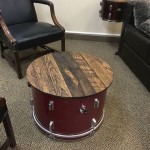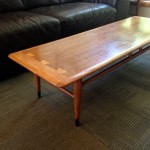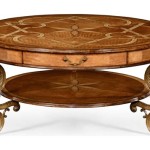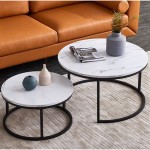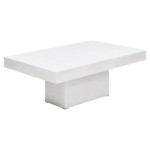How to Paint a Coffee Table for a Rustic Wooden Look
Achieving a rustic wooden look on a coffee table through painting is a popular and cost-effective way to enhance its aesthetic appeal and integrate it into a variety of interior design styles. This technique allows for customization, offering the opportunity to create a unique piece that complements an existing decor. The process involves careful surface preparation, strategic paint application, and the use of finishing techniques to mimic the natural wear and texture of aged wood. This article provides a detailed guide to painting a coffee table to achieve a convincing rustic wooden aesthetic.
The concept of "rustic" in furniture design typically implies a connection to nature, simplicity, and a sense of history. It often incorporates textures, imperfections, and a muted color palette that evokes a feeling of warmth and authenticity. When applied to a coffee table, a rustic finish can transform a modern or ordinary piece into a focal point with character and charm. The following steps will guide the reader through the transformation process.
Prior to commencing the painting process, it is crucial to gather the necessary materials and tools. This initial preparation is essential for ensuring a smooth and efficient workflow, minimizing potential disruptions, and ultimately achieving the desired aesthetic outcome. The required materials include:
- Cleaning supplies: A mixture of mild detergent and water will suffice.
- Sandpaper: Various grits, ranging from coarse (80-grit) to fine (220-grit), are recommended.
- Primer: Select a primer appropriate for the surface material of the coffee table (wood, laminate, metal).
- Paint: Choose paint colors that mimic natural wood tones, such as browns, grays, and off-whites. Acrylic or latex paint is generally suitable.
- Paintbrushes: A variety of brush sizes will ensure coverage of both large surfaces and detailed areas.
- Rags: Clean, lint-free rags are necessary for wiping surfaces and applying finishing treatments.
- Wood Stain (Optional): Choose a stain that complements the paint colors.
- Glaze (Optional): This adds depth and dimension to the rustic finish.
- Sealer: A matte or satin sealant will protect the painted surface.
- Drop cloth: To protect the work area from spills and splatters.
- Painter's tape: For masking off areas.
- Safety glasses and dust mask: To protect against paint fumes and dust particles.
Surface Preparation: The Foundation of a Rustic Finish
Proper surface preparation is paramount to achieving a durable and aesthetically pleasing rustic finish. Neglecting this step can lead to paint adhesion issues, an uneven texture, and a diminished overall appearance. The preparation process typically involves cleaning, sanding, and priming the coffee table.
The first step is cleaning the coffee table thoroughly. Remove any dust, dirt, grease, or existing finishes. Use a mild detergent mixed with warm water and a clean cloth to wipe down the entire surface. For stubborn stains or residue, a slightly stronger cleaning solution may be necessary. Once the surface is clean, allow it to dry completely before proceeding to the next step.
Sanding is critical for creating a textured surface that will enhance the rustic appearance. Begin with a coarse-grit sandpaper (80-grit) to remove any existing gloss or imperfections on the surface. Pay particular attention to edges and corners, which are often areas where wear and tear naturally occur. Sand in the direction of the wood grain (if applicable) to avoid creating unsightly scratches. After the initial sanding, use a medium-grit sandpaper (120-grit) to smooth out the surface and remove any rough edges created by the coarser grit. Finally, use a fine-grit sandpaper (220-grit) to create a smooth, even surface that is ready for priming.
After sanding, remove all sanding dust with a clean, damp cloth. Allow the surface to dry completely before proceeding to the priming stage. Priming is essential for creating a uniform surface that will promote paint adhesion and prevent the underlying material from bleeding through the topcoat. Choose a primer that is appropriate for the surface material of the coffee table (wood, laminate, or metal). Apply the primer evenly using a paintbrush or a sprayer. Allow the primer to dry completely according to the manufacturer's instructions before moving on to the painting stage.
Strategic Paint Application: Creating Depth and Texture
The strategic application of paint is where the transformation from an ordinary coffee table to a rustic wooden piece truly takes place. This involves selecting appropriate paint colors, applying them in layers, and utilizing techniques to create the illusion of age and wear. The goal is to mimic the natural variations in color and texture that are characteristic of weathered wood.
The first step is to choose a color palette that reflects the desired rustic aesthetic. Typically, this involves selecting a range of neutral colors, such as browns, grays, creams, and off-whites. Consider using a combination of these colors to create depth and dimension. For example, a base coat of dark brown can be followed by layers of lighter grays and creams to simulate the appearance of aged wood.
Apply the base coat evenly using a paintbrush or a sprayer. Allow the base coat to dry completely before proceeding to the next layer. Once the base coat is dry, use a dry-brushing technique to apply additional layers of paint. Dry-brushing involves dipping the tip of a paintbrush into the paint and then wiping off most of the paint onto a paper towel before applying it to the surface. This creates a textured effect with subtle variations in color. Focus on applying the dry-brushed paint in areas where wear and tear would naturally occur, such as edges, corners, and raised surfaces.
Another technique that can be used to create a rustic effect is layering different colors of paint. For example, a layer of dark brown paint can be followed by a layer of light gray paint, and then a layer of cream-colored paint. After each layer, use a fine-grit sandpaper to lightly sand the surface and reveal the underlying colors. This creates a layered effect that mimics the appearance of aged and weathered wood. The key is to be subtle and strategic in the application of paint, allowing natural variations in color and texture to emerge.
Optional techniques such as using wood stain or glaze can enhance the rustic effect. A wood stain can add a warm, rich tone to the coffee table, while a glaze can highlight details and create depth. Apply the wood stain or glaze sparingly, using a clean cloth to wipe off any excess. Experiment with different application techniques to achieve the desired effect.
Finishing Touches: Enhancing the Rustic Appeal
The finishing touches are crucial for solidifying the rustic aesthetic and protecting the painted surface. These steps involve sanding, distressing, and sealing the coffee table to create a durable and visually appealing finish. The goal is to enhance the illusion of age and wear while ensuring that the painted surface can withstand everyday use.
After the paint has dried completely, use a fine-grit sandpaper (220-grit) to lightly sand the surface. This will smooth out any rough edges and create a more refined texture. Pay particular attention to areas where the paint has been applied thickly or unevenly. Sand in the direction of the wood grain (if applicable) to avoid creating unsightly scratches.
Distressing is a technique that involves intentionally creating imperfections in the painted surface to simulate the appearance of age and wear. This can be achieved using a variety of tools, such as sandpaper, wire brushes, and chisels. Focus on distressing areas where wear and tear would naturally occur, such as edges, corners, and raised surfaces. Be careful not to over-distress the surface, as this can detract from the overall aesthetic. The key is to create subtle imperfections that enhance the rustic appearance without looking contrived.
After distressing, remove all sanding dust with a clean, damp cloth. Allow the surface to dry completely before proceeding to the sealing stage. Sealing is essential for protecting the painted surface from scratches, stains, and moisture. Choose a matte or satin sealant to maintain the rustic appearance. Apply the sealant evenly using a paintbrush or a sprayer. Allow the sealant to dry completely according to the manufacturer's instructions. Multiple coats of sealant may be necessary for added protection. Lightly sanding between coats can help to create a smoother, more durable finish.
Furthermore, consider adding decorative elements to further enhance the rustic aesthetic. These can include adding decorative hardware, such as vintage handles or knobs, or attaching reclaimed wood accents to the coffee table. These small details can add character and charm, solidifying the rustic theme.
In summary, painting a coffee table to achieve a rustic wooden look is a multi-step process that requires careful preparation, strategic paint application, and the use of finishing techniques. By following these steps, it is possible to transform an ordinary coffee table into a unique and visually appealing piece that complements a variety of interior design styles. The key to success is to be patient, pay attention to detail, and experiment with different techniques to achieve the desired aesthetic outcome.

Diy World Market Coffee Table Makeover Liz Marie Blog

Distressed Coffee Table A Revisit Rework The Painted Hive

How To Refinish A Rustic Wood Coffee Table With Beautiful Results

The Boho Coffee Table Milk Paint Experiment I Re Stuff

How To Refinish A Rustic Wood Coffee Table With Beautiful Results

Chalk Paint Coffee Table Makeover Step By Diy Guide Bricks N Blooms With Stacy Ling

Diy Painting Aging Techniques For Living Room Coffee Tables My Desired Home

Distressed Coffee Table A Revisit Rework The Painted Hive

Rustic Coffee Table Makeover Life On Kaydeross Creek

How To Refinish A Table Farmhouse Style My 100 Year Old Home
Related Posts

